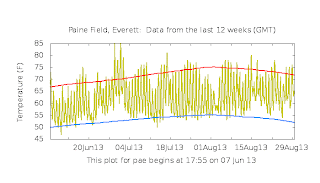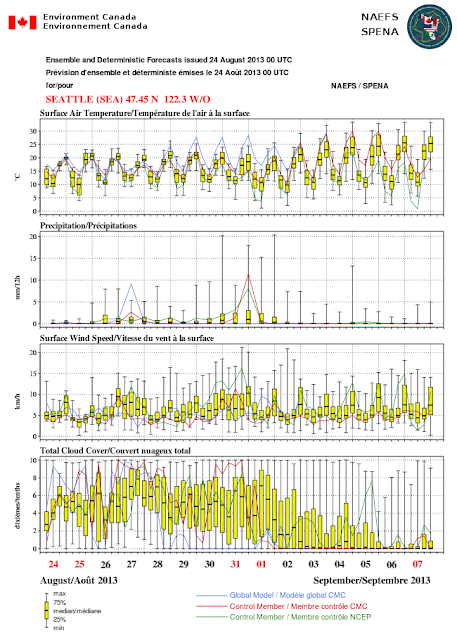And we are amazed, and unprepared. Our streets flood, water fills basements, sewers overflow. And this in a region supposedly web-footed and Goretex-ready. What is going on?
First...the "big" event on Thursday.
Marine Drive in Everett on Thursday evening
Local media had a field day
Between four and 6 PM that day, a line of moderate-intensity thunderstorms moved northward up Puget Sound. Here is a sample radar image around 5 PM (reds indicate very heavy precipitation). Impressive for around here.
Based on rain gauges and radar, the heaviest totals from this event reached 1-1.5 inches , with the regions from Edmonds to Everett and Renton to Sammanish being particularly hard hit. This is supported by the 24-h rainfall totals from CoCoRahs rain gauges (shown here), although keep in mind most of this fell within one hour on Thursday.
Many locations got most of their rainfall in 15-30 minutes...a real downpour for around here.
Now, time for irony. We think we are rain-accustomed folks with moss between our teeth, but the truth is that we are heavy-rain wimps. We rarely get intense rain, with a half-inch or more in an hour, and generally experience relatively gentle, but long-lived precipitation events. As a result, our drainage infrastructure and roads have generally not been designed to handle intense short-period rainfalls, rain generally associated with thunderstorms.
To illustrate our lack of intense rain compared to the rest of the nation, here is an official NWS analysis of what should be the biggest 1-h rainfall over a period of ten years. If you can read the tiny numbers, you will see that the eastern portion of the U.S. gets FAR heavier precipitation...with their ten-year values reaching 2-3 inches, while ours is only about .5 inch.
The big reason for the difference is that they get lots of thunderstorms, including plenty of strong ones. We get few thunderstorms and they generally are not intense. Why fewer thunderstorms? The cool Pacific is a major reason.
My general observation is that less than .2 inches and hour things are generally ok. Hit .5 inch an hour and some urban flooding occurs. Get to inch an hour and serious flooding and damage occurs. This happened in some areas (e.g., near Everett) this week. And it happened on December 14, 2006 before the Chanukah Eve storm. Nearly an inch fell in a swatch from West Seattle to Kirkland and tragically a woman died from flooding in her basement. In order to better prepare for such intense precipitation events, the City of Seattle maintains a dense rain gauge network over the city and has supported the development of the Seattle RainWatch application that combines weather radar and rain gauges to describe what is happening in real time, to predict the next hour, and to warn when necessary (see image).
Finally, considering that some of our region's infrastructure can't handle even current major precipitation events and the potential exist for even heavier events under global warming (but is uncertain), future infrastructure projects should be built with better drainage in mind.























































